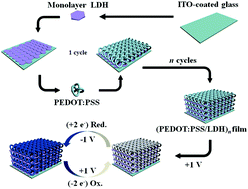The fabrication of oriented organic–inorganic ultrathin films with enhanced electrochromic properties†
Abstract
Electrochromic films have shown great application prospects in electronic display and information storage. In this work, we report the fabrication of electrochromic ultrathin films (UTFs) by layer-by-layer (LBL) assembly of layered double hydroxide (LDH) nanosheets with poly(3,4-ethylene-dioxythiophene)–poly(styrene sulphonate) (PEDOT:PSS). UV-vis absorption spectra illustrate the uniform and regular growth of the UTFs. The X-ray diffraction results indicate that the (PEDOT:PSS/LDH)n UTFs possess long-range ordered stacking in the normal direction of the substrate, with PEDOT:PSS accommodated between the LDH nanosheets. SEM and AFM images demonstrate a continuous smooth surface of the (PEDOT:PSS/LDH)n UTFs without aggregation. The (PEDOT:PSS/LDH)n UTFs exhibit an improved ion transfer kinetics, owing to the high dispersion of PEDOT:PSS and the presence of an ordered superlattice architecture. This leads to significantly enhanced electrochromic performance, including ultrafast switching speed (0.27/0.18 s for coloring/bleaching response), high optical contrast (ΔT = 32%, at 650 nm) and satisfactory coloration efficiency (159 cm2 C−1). Therefore, this work provides a feasible method to construct high-performance electrochromic films, which are promising candidates for application in optical/optoelectronic devices.


 Please wait while we load your content...
Please wait while we load your content...